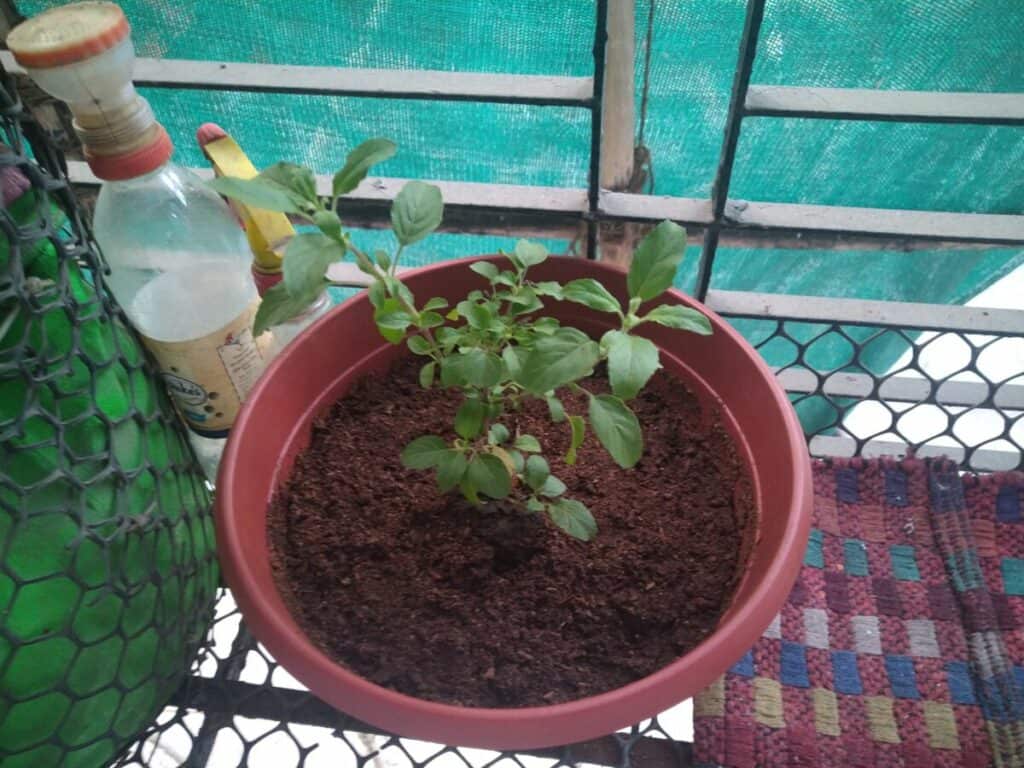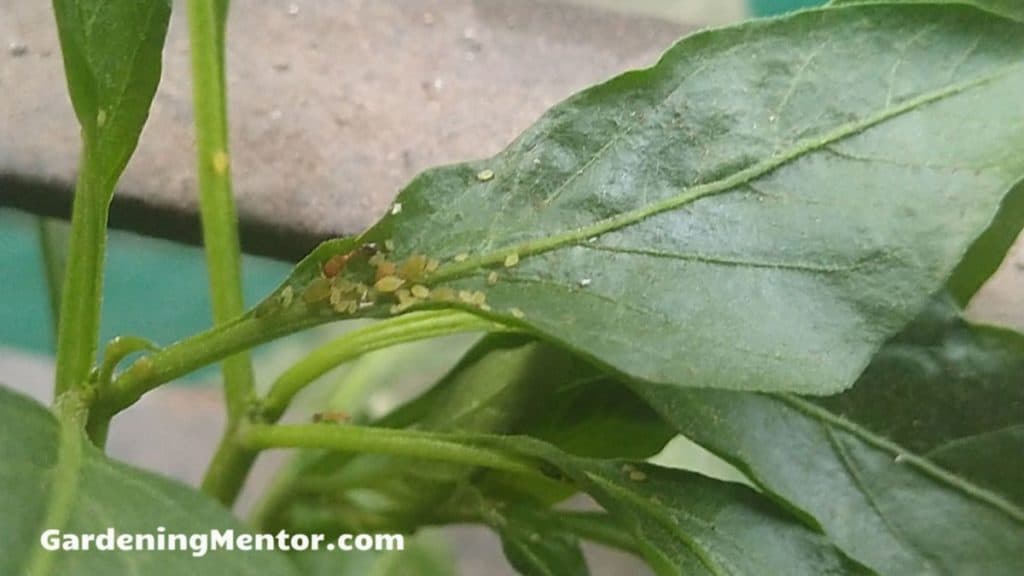When you grow plants, bugs are bound to reach them. But what about potted plants? Will they face the same problem?
Indoor plants or houseplants attract bugs because of growing conditions such as high humidity, poor air circulation, and shade. Indoor plants or houseplants have fewer bugs than outdoor plants due to the protected indoor environment. Bugs can be either pests or beneficial insects.
I’ve written details below on why potted plants attract bugs, how you can prevent such bugs, and what to do if you already have a bug infestation. So keep reading.
Why do potted plants attract bugs?
Whether you grow potted plants indoors or outdoors, they attract bugs due to the same reasons.
1. Humid conditions in the potted plants
The most common reason bugs reach potted plants is humid conditions near the plant. Bugs need a humid environment so they can keep their bodies moist.
Such humid conditions may happen because you are splashing a lot of water on the foliage. If you’re growing plants indoors, some of the rooms in your house might have high humidity.
The lack of air circulation in the foliage can also lead to humid conditions that attract bugs. This may happen if the foliage becomes very dense. Or if you’re growing plants very close to each other.
2. Poor potting soil
If you use potting soil that has been lying around for a while, it could already contain bugs. The same could happen if you use garden soil that may contain bugs.
The bugs could reach your potted plant if you reused potting soil from the previous year without sterilizing it.
3. Transplants brought from a nursery
The bugs may already have been a part of the plant if you bought them from a nursery.
There might have been humid conditions where the plants were growing and attracted the bugs. Or they got introduced to the plants from the other plants they were grown together.
The truth of the matter is that, no matter how careful you are not to buy plants that are already infested by bugs, you cannot be a 100% sure that you are bringing in bug-free plants to your indoor garden. (pests.org)
4. Lack of predators in the potted plants
When plants grow outdoors, nature balances the bugs on the plants with the cycle of life. Predators like beneficial insects, birds, and animals eat the bugs and keep their population in check.
The potted plants you grow may be in an environment that has a lack of predators. This is especially true when growing the plants indoors.
The lack of such predators could encourage the increase in the population of bugs on your potted plants.
Should you be worried about bugs on potted plants?
Before you go about trying to prevent or remove bugs from your potted plants, I want to remind you that not all bugs are bad.
There are beneficial insects that you should have on your potted plants. They will protect your plants from harmful pests. And there are some that just stay on the plant and don’t affect it.
In fact, the list of bugs that are not harmful is much longer than the ones that may cause your plants harm.
So when you go about killing bugs, you’ll also end up harming the good ones. My advice is not to panic when you have bugs on your plants.
Some bugs are fine, and I would suggest you just let them be. A few insects won’t harm your plants. Only if you find an infestation that is starting to cause issues should you worry about this.
Of course, if you’re growing potted plants indoors, you may not want bugs in your house. Then it’s your choice if you want to get rid of them.
How to prevent bugs on potted plants
The best way to protect your potted plants is to prevent the bugs from reaching them in the first place.
Be careful when buying transplants
You may be getting your potted plants from a nursery or garden center. I would suggest you check the plants before you buy them.
If the plants are well maintained with good air circulation and high-quality potting soil, there should be no bugs. If you notice any bugs on the plants, avoid buying them.
Ensure to check all parts of the plant, including the underside of the leaves where bugs hide. You can also remove the plant from the pot and check the roots and soil for signs of any bugs. Check inside the pot as well for signs of any pests.
When you get the transplant to your house, make sure to keep it away from the other plants for a few days. This will help ensure that even if there are some bugs in the new plant, they won’t reach your existing plants.
Once you have observed the transplant for a few days and noticed no bugs, you can move it together with your other plants.
Avoid humid conditions in the potted plants
You want to keep your potting soil moist but avoid moisture on the foliage because it attracts the bugs.
I recommend only watering the potting soil and not splashing water on the foliage. It’s best to use a watering can instead of a hose to water your plants.

You could consider watering your plants from the bottom, where you place the pot in a tray filled with water. The soil absorbs the water and makes it available to the roots.
It’s best to water plants in the morning. This will help evaporate excess moisture from the foliage when the sun comes out.
Make sure there are drainage holes in your pots. This helps drain out the excess moisture from the potting soil.
Remember to keep a good distance between your potted plants, so there is good air circulation. Prune the foliage every few weeks, so there is good airflow among the leaves.
Keep the potted plants clean
Many bugs prefer to stay in locations that have dead or decaying matter, such as dried leaves and foliage. It’s best to clean up your potted plants and remove such debris.
Check your potted plants every day so you can take care of such unwanted materials as soon as you notice them.
Monitor your potted plants every day
I recommend you check on your potted plants every day to know what is going on with them.
This will help you find out if any bugs have just started attacking your plants. You can then observe them and take care of them if they cause problems to the plants.
Use good potting soil for the plants
Bugs can reach your potted plants through poor soil. So make sure to use good potting soil when preparing the pot.
Don’t use garden soil for the potted plants because they may contain a lot of such bugs. You may find the same problem if you try to reuse old potting soil from the previous year.
You can sterilize such potting soil before use for the plants. The simplest way to do this is to heat it in the oven at 120 degrees Fahrenheit for an hour. Let the soil cool, and then you can use it for your potted plants.
Quarantine the infested potted plant
If one of your potted plants has been attacked by bugs, it’s best to isolate it from the rest of the plants. This will help prevent the bugs from spreading to all of your other potted plants.
You can treat the affected potted plant with the necessary methods to get rid of the bugs. And once you are sure the problem is solved, get it back to the other potted plants.
Grow potted plants that deter pests
There are certain plants you can grow that bugs don’t find attractive and tend to avoid. These plants are still beautiful and fragrant. Here’s a list of a few such plants you can choose from.
Most herbs fit into this type of plant because they have an intense fragrance that many bugs don’t prefer.
| Snake plant | Airplants | Bromeliads |
| Chinese Evergreen | Jade Plant | Aglaonema |
| Dracaena | Coleus | Grape Ivy |
| Catnip | Lavender | Mosquito Plant |
| Cast Iron Plant | Basil | Chives |
| Mint | Thyme | Parsley |
| Marigold | Lemon Balm | Sage |

How do I get rid of bugs in my potted plants
Identify the bug that has infested the plant
The first thing to do is identify the type of bug that is on the plant. You can find out whether it’s a beneficial insect or not and take action.
Several websites can help you find out more about garden insects.
List of websites to identify bugs:
One of the best things you could do is take a photo and post it in mobile apps to help match what kind of bug it is.
List of mobile apps to identify bugs:
- Picture Insect – Bug Identifier – Android
- Seek by iNaturalist – Android
- Insect Identification – iOS
- Picture Insect – Bug Identifier – iOS
- Seek by iNaturalist – iOS
You could also take a picture and post it in some gardening groups on Facebook to get help identifying the bug.
Separate the plant from the rest of the plants
It’s best to isolate the affected plant from the rest of your potted plants. This will prevent the bugs from spreading to all of your plants.
Keep it isolated till you have treated the plant for several weeks and are fully sure there are no more bugs remaining on the plant.
Find out how extensive is the problem
You can have a few bugs on the plant, but you don’t need to panic as it’s part of nature. If the bugs are increasing in number and causing damage to the plant, you need to take care of them.
Use an organic solution to get rid of the bug
Once you have figured out what bug is attacking the plant, you can try using organic methods to get rid of it.
The type of organic method to use will depend on the type of bug. So make sure to use Google search and the advice of fellow gardeners on forums and groups.
Compared with outdoor plants, the kinds of bugs you’re likely to find on indoor plants is limited to only 7 species – spider mites, mealy bugs, scale, aphids, thrips, whitefly, and fungus gnats. (quora.com)
If the bugs are large, you can just handpick them and drop them in a solution of soapy water. This works well for slugs, snails, caterpillars, hornworms.
If the insects are small, you could dislodge them with a spray of water. This works well for insects like aphids and thrips.

You’ll need to spray an organic solution or powder for some of the pests to get rid of the problem.
If they are scale insects, you could get rid of them using diatomaceous earth. This material has sharp, microscopic, fossilized remains of aquatic creatures. It cuts the bodies of such insects and dehydrates them to kill them.
Some other common organic solutions include neem oil, insecticidal soap, garlic spray, pepper spray, and rubbing alcohol.

Fact Checked, Written, and Published by Kevin Rodrigues
Kevin is the founder of Gardening Mentor, a website that aims to teach people to grow their own food in a limited space. As a self-taught gardener, Kevin has spent several years growing plants and creating gardening content on the website. He is certified in Home Horticulture and Organic Gardening from Oregon State University. He has a Post Graduate Diploma in Horticulture and Landscape Gardening from Mumbai University.
Read more
